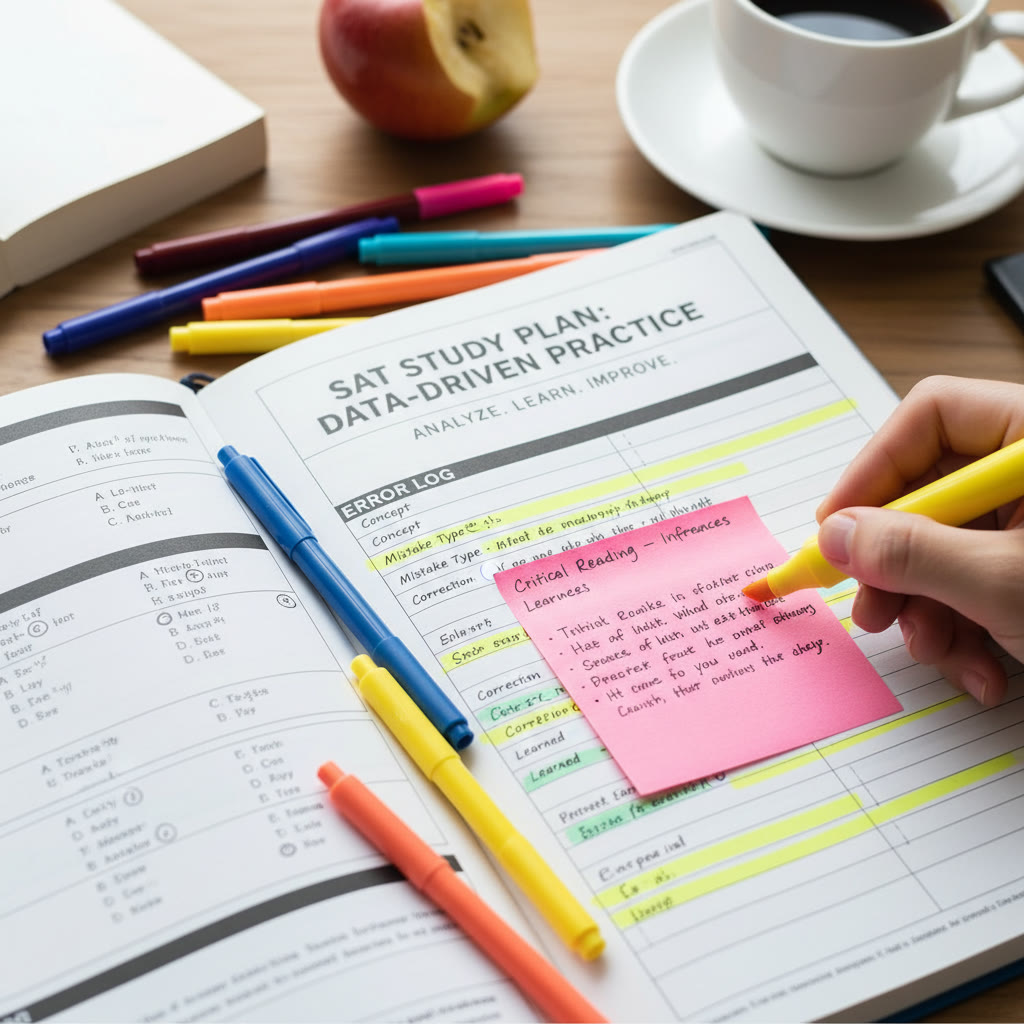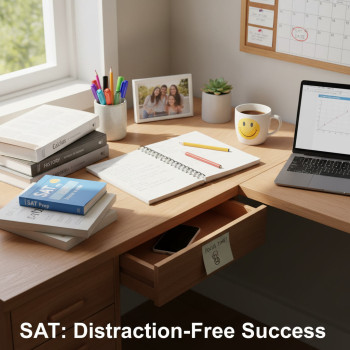The Student Journey of Breaking Score Plateaus
Hitting a score plateau on the SAT feels like running on a treadmill: you sweat, you push, you log hours—and the number on the scoreboard barely budges. If you’re reading this, you’ve likely experienced that frustrating cycle. The good news? Plateaus are not a judgement; they’re a diagnostic. A plateau tells you where to look, what to fix, and how to change course. This post is a friendly, practical guide that walks you through the emotional and tactical steps to break through and finally see sustainable improvement.
Why plateaus happen (and why they’re normal)
Before we talk tactics, let’s normalize the experience. Plateaus happen for predictable reasons:
- Skill vs. Score Gap: You may have improved skills but not trained them under test-like conditions (timing, fatigue, pressure).
- Practice without precision: Doing many problems is different from practicing the right problems with targeted feedback.
- Comfort zone bias: Students often avoid the hardest question types where the most points are gained.
- Poor analytics: Not tracking error types or failing to analyze practice tests means repeating the same mistakes.
- Burnout and inconsistency: Too much cramming or too many short, unfocused sessions leads to diminishing returns.
Recognizing which of these applies to you is the first leap toward climbing past a plateau.
Mindset reset: Curiosity beats panic
When your score stalls, anxiety is the natural response—but curiosity is the productive one. Instead of thinking “I’m stuck,” ask precise questions:
- Which section lost me the most points on my last practice test?
- Are my mistakes clustered (e.g., algebra II, inference questions, comma rules)?
- How does my timing look across sections?
- Am I doing exercises that are slightly harder than my current level or slightly easier?
Framing the problem with curiosity turns uncertainty into experiments. You’ll be running controlled tests—tweaking practice type, timing, or strategy—rather than guessing in the dark.
Diagnose first: Use data, not intuition
The fastest route beyond a plateau begins with a careful diagnosis: a full practice test taken in realistic conditions, followed by disciplined analysis.
What a good diagnostic looks like
- Complete, timed practice test (Reading 65 min, Writing & Language 35 min, Math 80 min split between no-calculator and calculator).
- Score the test and record section and subsection breakdowns (e.g., Passage A Reading question types, Heart of Algebra in Math).
- Log every mistake in an error notebook: question, answer, why you missed it, and what you’ll do to fix it.
Keep these diagnostics regular—every 2–3 weeks—and compare not just raw scores but patterns. The plateau often hides patterns that only appear across multiple tests.
Sample error log entry
Here’s a practical way to structure entries in your error log:
- Test/Date: Official Practice Test 4 — 2025-02-03
- Section: Math — No Calculator
- Q#: 12
- Type: Linear equations with fractions
- Mistake: Sign error when clearing denominator
- Fix Plan: Slow down during algebra steps; rewrite each fractional expression, check sign when multiplying by negative.
Targeted practice: Quality over quantity
Long hours can feel productive, but what truly moves scores is targeted practice: pick specific weaknesses, set measurable goals, and apply deliberate repetition with increasing difficulty.
How to build a targeted practice session
- Start with a 10–15 minute warm-up of questions you can solve reliably to build confidence.
- Spend the bulk (30–45 minutes) on the narrow skill you identified—e.g., author’s purpose, function of a comma, systems of equations.
- Finish with a 10–15 minute timed mini-section (5–10 questions) focusing on speed and accuracy.
- End each session by logging errors and noting a single micro-habit to practice next time.
Over weeks, adjust which skill is in the center based on your diagnostic tests. If error types shift, pivot your drills accordingly.
Deliberate practice example: Reading
Instead of reading random passages, tackle one focused challenge for a week—say, inference questions. Work on:
- Identifying the author’s stance quickly.
- Practicing paraphrasing complex sentences in one line.
- Eliminating answer choices with extreme language before analyzing the subtler ones.
Repeat this across three practice passages under timed conditions. This concentrated repetition deepens the exact skill that will yield the most points.
Master timing and test-game strategies
Often, a plateau is partly a timing problem. You know how to solve many problems—but not fast enough, or you squander time on the wrong ones. Time management is a high-leverage area to attack.
Simple timing rules to implement now
- Know your target pacing: Reading ~13 minutes per passage, Writing & Language ~9 minutes per passage, Math questions—aim for ~1–1.5 minutes per question on No Calculator and slightly faster on some Calculator questions.
- Use a flag system: Attempt easy questions quickly, flag hard ones to return to if time allows.
- Practice sectional pacing—take a single section under real timing every week.
Timing practice is not just about speed; it’s about triage. Learn to identify what’s solvable quickly and what’s a sunk time cost.
When to guess and when to grind
Smart guessing preserves time and avoids leaving easy points on the table. If a question is taking longer than your per-question pace and you’re not making progress after 30–45 seconds, make an educated guess and move on. That saved time might let you confidently finish a later question you would have otherwise missed.
The power of error patterns and conceptual patches
Fixing one-off errors is useful; fixing systemic problems is transformative. Look for conceptual patches—short, repeatable practices that address a recurring mistake.
Common conceptual patches
- Algebra sign-check ritual: For every multi-step algebra problem, add one step: rewrite the equation after each operation to catch sign mistakes.
- Reading paraphrase habit: After reading any paragraph, write a one-sentence paraphrase—this trains comprehension and reduces sloppy inference mistakes.
- Punctuation checklist: For Writing & Language, use a three-item checklist: subject-verb agreement, modifier placement, punctuation clarity.
These small rituals become mental scaffolding. Over time they consume less conscious effort and become automatic corrections for prior weaknesses.
Build a practical study plan (sample 8-week roadmap)
Below is a sample, realistic 8-week plan designed to nudge a student out of a plateau. Customize it to your starting score and available hours.
| Week | Focus | Weekly Routine | Goal |
|---|---|---|---|
| 1 | Full diagnostic & error logging | 1 full practice test, 4 targeted 45-min sessions, start error log | Baseline; identify top 3 weaknesses |
| 2 | Targeted skill training | 3 sessions focused on weakest topic, 1 timed section | Eliminate frequent mistake pattern |
| 3 | Timing and triage | 2 full timed sections, pacing drills, error review | Improve pacing by 10–20% |
| 4 | Mixed practice | Mix topics under time, 1 practice test | Increase accuracy in mixed sets |
| 5 | Advanced problem types | Work on hardest question types, 2 timed mini-tests | Make progress on previously avoided questions |
| 6 | Simulation and stamina | 1 full practice test, long study blocks to build stamina | Reduce end-of-test fatigue errors |
| 7 | Refine strategies | Targeted reviews, test-day routine, mental prep | Consolidate habits and rituals |
| 8 | Final tuning | 2 practice sections, light review, confidence-building | Peak performance on test day |
This roadmap is intentionally flexible. If you have more time, add an extra practice test every two weeks. If you have less, focus on the diagnostics, one targeted skill per week, and pacing practice.
How much time is realistic?
Forty-five focused minutes a day 4–5 days a week beats three hours of distracted study once a week. Consistency builds neural pathways; precision builds skill. Aim for 10–15 quality practice sessions a month, with regular full tests to track progress.
Practice tests: not just for scoring, but for learning
Practice tests are your laboratory. The test itself is the measurement—but the experiment is how you use the data.
How to review a practice test effectively
- Never skip review. Spend at least as much time reviewing the test as you did taking it.
- For each mistake, ask: careless error, knowledge gap, or strategy failure?
- Group mistakes into patterns: grammar rules, algebra steps, question types. Then assign micro-practice drills to each group.
Tracking the same categories across multiple tests reveals trends that single-test scores hide. That’s how you move from random improvement to reliable gains.
When to get outside help: tutors, mentors, and Sparkl’s personalized tutoring
Plateaus can sometimes be a structural problem: you’re missing a piece of the puzzle that a trained eye can spot quickly. That’s a natural time to consider outside help. A quality tutor can:
- Provide 1-on-1 guidance focused on your exact weaknesses.
- Create tailored study plans that evolve as you improve.
- Offer real-time debugging for your problem-solving process.
For students who want a mix of human touch and tech-driven feedback, services like Sparkl’s personalized tutoring blend expert tutors with AI-driven insights. That means you get a tutor who understands your specific error patterns, a study plan shaped to your life, and AI analytics that track progress across categories—helpful when you’re trying to extract gains from a stubborn plateau.
How to get the most from a tutor
- Bring your error log to every session—specific questions, not vague complaints.
- Ask for explicit strategies you can practice independently (not just explanations in-session).
- Set short-term measurable goals with your tutor: number of concepts fixed, average time per question, or consistent score brackets on practice sections.
Real-world habits that matter on test day
Improvement isn’t only about content. Your habits shape performance: sleep, nutrition, and test-day routine influence the brain’s ability to recall and apply skills under pressure.
Practical, evidence-based habits
- Sleep: Aim for 8–9 hours the night before the test. Sleep consolidates memory—cramming the night before is low-value.
- Nutrition: A balanced breakfast with protein and complex carbs fuels sustained concentration. Avoid high-sugar breakfasts that spike energy then crash it.
- Warm-up: Do a short 15–20 minute warm-up of easy, confidence-building questions before the test to prime your brain.
- Mindset routine: Use 2–3 calming breaths, a quick positive reminder of your preparation, and a small physical ritual (e.g., tighten and relax your fist) to reduce nerves.
Examples and small experiments you can run this week
Try these short experiments and track what changes:
- Swap one unfocused hour for two 25-minute Pomodoro sessions of targeted practice and see which yields better retention.
- On one practice test, restrict yourself to only two “returns” per section (force faster triage). Compare accuracy on remaining questions.
- For two weeks, add a five-minute paraphrase practice for every reading passage you do and record error shifts on inference questions.
Small experiments like this are low-cost and reveal what works for you. The cumulative effect of many tiny improvements often explains big jumps in score.
When you’ll know you’ve broken the plateau
It’s not a single moment; it’s a pattern. You’re breaking the plateau when:
- Your practice tests show consistent improvement across at least three exams.
- Previously recurring mistakes are gone or notably reduced.
- You finish sections with time to spare and fewer random guesses.
- Your confidence shifts from anxious to prepared—you still feel pressure, but it’s focused energy rather than panic.
Celebrate these signs. Breaking a plateau is as much about habit and structure as it is about raw knowledge.
Parting thought: treat the SAT like a craft
Think of your SAT prep as a craft you’re learning. Crafts improve through feedback loops—try, fail, refine, repeat. Plateaus are the natural checkpoint in that loop. They’re uncomfortable because you care, but they’re also where the most meaningful learning happens.
If you ever feel stuck, remember: targeted diagnostics, disciplined error analysis, smart timing strategies, and consistent micro-practice sessions produce steady results. And if you want personalized support to accelerate that work, consider resources that offer 1-on-1 guidance, tailored study plans, expert tutors, and data-driven insights—those elements often speed recovery from plateaus.


Break the problem into pieces. Be curious. Measure. Iterate. That’s how students move from stuck to steadily improving—and from worrying about a single test to mastering a reproducible process. The plateau is not the end of your story; it’s the moment that tells you exactly what to fix next.
Now breathe, choose one micro-experiment from this post, and start. You’ll be surprised how fast the needle moves when the practice is precise.






















No Comments
Leave a comment Cancel